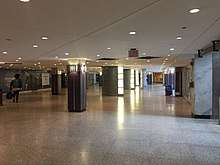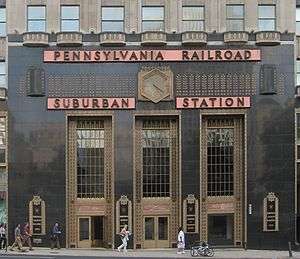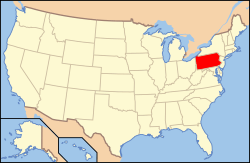Suburban Station
Suburban Station is an art deco office building and underground commuter rail station in Penn Center, Philadelphia. Its official SEPTA address is 16th Street and JFK Boulevard.[2] The station is owned and operated by SEPTA and is one of the three core Center City stations on SEPTA Regional Rail. The station was built by the Pennsylvania Railroad to replace the original Broad Street Station and opened on September 28, 1930.
History
The station opened as a stub-end terminal for Pennsylvania Railroad commuter trains serving Center City Philadelphia, intended to replace the above-ground Broad Street Station in this function. The station's full name was originally Broad Street Suburban Station. It also includes a 21-story office tower, One Penn Center, which served as the headquarters of the PRR from 1930 to 1957.
When Amtrak took over the Silverliner Service from Penn Central in 1972, it was operated as a quasi-commuter service that terminated at Suburban Station.[3][4] The trains were named Keystone Service in 1981.[5][6] By the late 1980s, the Metroliners used for the service were in poor shape, but Amtrak had a shortage of AEM-7 locomotives due to wrecks. On February 1, 1988, Amtrak converted all Keystone Service trains to diesel power and terminated them on the lower level of 30th Street Station, as diesel-powered trains were not allowed in the tunnels to Suburban Station.[6] The change was listed as "temporary" on timetables starting on May 15, 1988 and lasting into 1990.[7][8]
Suburban Station was originally a stub-end terminal station with eight tracks and four platforms. Plans for a tunnel to link the Pennsylvania and Reading commuter lines were floated as early as the 1950s, but funding to seriously study the project did not start until SEPTA's formation in the late 1960s. The project languished in the 1970s for want of funding until federal money was appropriated during Philadelphia mayor Frank Rizzo's time in office. SEPTA took over operation of all commuter rail service in the Philadelphia area in 1983; it had previously contracted their operations to Conrail from 1976 to 1983 and to PRR and Reading from 1966 to 1976.
The long-awaited link between the old PRR and Reading lines, the Center City Commuter Connection, opened in 1984. It extended four tracks eastward to the new Market East Station (now Jefferson Station), widened two of the existing platforms, added a fifth platform and realigned the tracks. The recently renovated building above is also the core of the Penn Center office complex, and is known as One Penn Center at Suburban Station. The office building attained an Energy Star Rating in 2009.[9]
BLT Architects transformed Suburban Station in 2006. The station was redesigned to make navigation easier and adapt to current pedestrian traffic.[10] Upgrades included increased retail space, a reactivated and improved HVAC system, and a restored/refurbished waiting area. The station is now in full compliance with the Americans with Disabilities Act of 1990. The Comcast Center, situated on the north half of its block near Arch Street, adds a "winter garden" on the south side, which serves as a new back entrance to the station, with the commuter rail tracks about 50 feet below street level.
Services
All SEPTA Regional Rail trains stop at this station. All run through except those on the Cynwyd Line as well as some limited/express trains which terminate on one of the stub-end tracks at this station. Through trains usually change crews at this station.
The station has an extensive concourse level above track level. This concourse has SEPTA ticket offices, retail shops and restaurants, and access to other SEPTA stations and to several Center City buildings. The connections, via the large Center City Concourse, include the Broad Street Line at City Hall station, the Market-Frankford Line and Subway-Surface Lines at the 15th Street station, and the PATCO Speedline at 15–16th & Locust station.[11]
Station layout
The station has a total of 8 tracks and 5 island platforms.
| G | Street level | Exit/entrance, buses |
| B1 | Concourse | Ticketing, shops, Downtown Link concourse to 15th Street/City Hall stations |
| B2 Platform level |
Track 7 | ← Paoli/Thorndale Line toward Thorndale (30th Street Station) |
| Island platform | ||
| Track 6 | ← Cynwyd Line toward Cynwyd (30th Street Station) | |
| Track 5 | No regular service | |
| Island platform | ||
| Track 4 | ← Paoli/Thorndale Line toward Thorndale (30th Street Station) ← Trenton Line toward Trenton (30th Street Station) | |
| Island platform | ||
| Track 3 | ← Chestnut Hill West Line toward Chestnut Hill West (30th Street Station) ← Airport Line toward Airport (30th Street Station) ← Wilmington/Newark Line toward Newark (30th Street Station) ← Media/Elwyn Line toward Elwyn (30th Street Station) | |
| Track 2 | Airport Line toward Glenside (Jefferson) → Warminster Line toward Warminster (Jefferson) → West Trenton Line toward West Trenton (Jefferson) → Chestnut Hill East Line toward Chestnut Hill East (Jefferson) → | |
| Island platform | ||
| Track 1 | Fox Chase Line toward Fox Chase (Jefferson) → Lansdale/Doylestown Line toward Doylestown (Jefferson) → Manayunk/Norristown Line toward Norristown-Elm Street (Jefferson) → | |
| Island platform | ||
| Track 0 | No regular service | |
Gallery
- Aerial view of Suburban Station
 Regional Rail platforms
Regional Rail platforms Underground entrance
Underground entrance Waiting area
Waiting area Concourse shops
Concourse shops Concourse shops
Concourse shops Entrance to the concourse
Entrance to the concourse
References
- "National Register Information System". National Register of Historic Places. National Park Service. January 23, 2007.
- SEPTA | Suburban Station
- Baer, Christopher T. (April 2015). "A GENERAL CHRONOLOGY OF THE PENNSYLVANIA RAILROAD COMPANY ITS PREDECESSORS AND SUCCESSORS AND ITS HISTORICAL CONTEXT: 1972" (PDF). Pennsylvania Railroad Technical & Historical Society.
- Nationwide Schedules of Intercity Passenger Service. National Railroad Passenger Corporation. October 29, 1972. p. 43 – via Museum of Railway Timetables.
- Amtrak National Train Timetables. Amtrak. October 25, 1981. p. 22 – via Museum of Railway Timetables.
- Baer, Christopher T. (April 2015). "A GENERAL CHRONOLOGY OF THE PENNSYLVANIA RAILROAD COMPANY ITS PREDECESSORS AND SUCCESSORS AND ITS HISTORICAL CONTEXT: 1980-1989" (PDF). Pennsylvania Railroad Technical & Historical Society.
- Amtrak National Train Timetables. Amtrak. May 15, 1988. p. 65 – via Museum of Railway Timetables.
- Amtrak National Train Timetables. Amtrak. April 1, 1990. p. 69 – via Museum of Railway Timetables.
- "Suburban Station". Emporis.com. Retrieved 8 May 2008.
- BLTa Architects: Suburban Station
- "Downtown Link Center City Concourse". SEPTA. Retrieved September 2, 2019.
External links
![]()
- SEPTA - Suburban Station
- Pennsylvania Railroad - Suburban Station (Pennsylvania Railroad Stations; Past & Present)
- JFK Boulevard and 17th Street entrance from Google Maps Street View
- JFK Boulevard and 18th Street entrance from Google Maps Street View
- JFK Boulevard and 16th Street entrance from Google Maps Street View
- 16th Street entrance from Google Maps Street View
- Main entrance from Google Maps Street View
- JFK Boulevard and 15th Street entrance from Google Maps Street View





